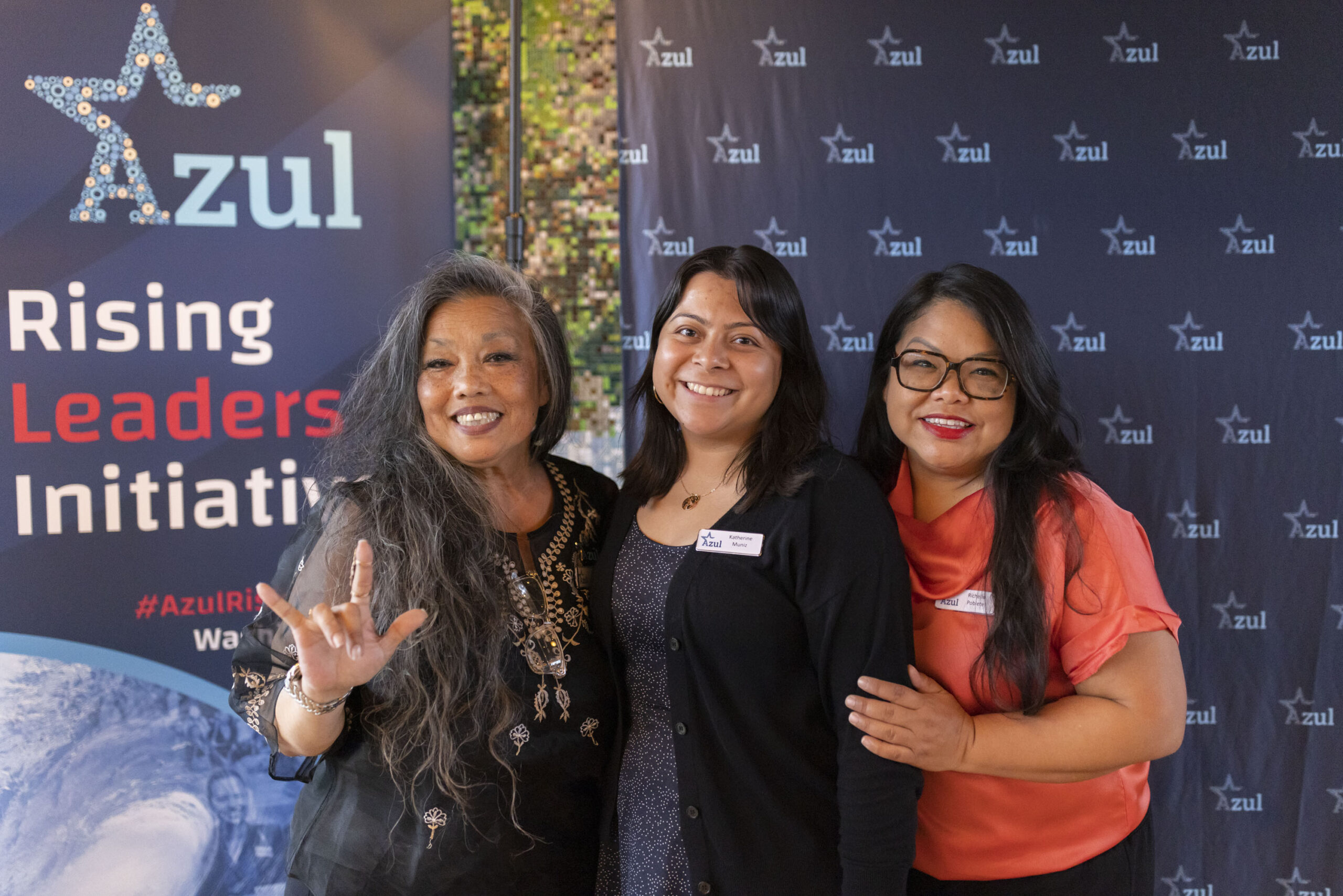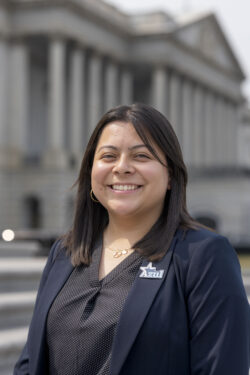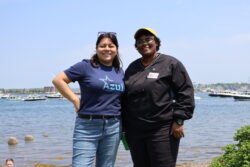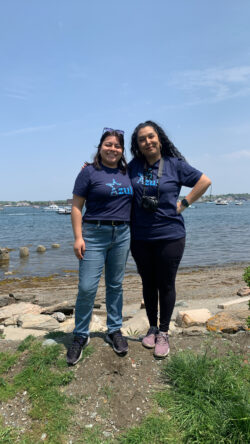
Hispanic Heritage Month: Q&A with Katherine Muniz

Katherine Muniz, Azul’s RAY policy fellow, poses during Semana Azul in Washington, D.C. in June 2023. Credit: Azul.
Written by: Katherine Muniz, Ray Policy Fellow at Azul
Editor’s note: Katherine Muniz is a Ray Policy Fellow at Azul, a Latinx-led and serving grassroots environmental justice organization, which continues to be the only U.S. ocean conservation organization in the nation to focus specifically in working with Latinx communities to protect the ocean and coasts.. The Roger Arliner Young (RAY) Fellowship Program is a two-year paid fellowship designed to equip recent college graduates with the tools, experiences, support, and community they need as emerging leaders of color in the conservation movement. Katherine identifies as a Latina.
Why is it important for Hispanic and Latinx youth to have the opportunity to experience the ocean firsthand and/or be inspired by Hispanic and Latinx role models?

Azul’s RAY Policy Fellow, Katherine Muniz is all smiles alongside a local ocean advocate as #LatinosMarinos movement makers new and old gathered at the Ocean Race in Newport, Rhode Island. The Bay is featured behind them. Credit: Azul
The ocean offers numerous opportunities and benefits for people of color, including its profound cultural and spiritual significance in many Hispanic and Latinx communities. Our personal experiences with the ocean are both captivating and enlightening – leading to a transformative shift in perspectives and solutions for ocean justice, underscoring the significance of our representation in ocean conservation efforts. I believe representation plays a vital role for Hispanic and Latinx youth by promoting a deeper understanding and stronger connections. Additionally, it inspires Hispanic and Latinx youth to visualize themselves in roles and careers they may not have otherwise considered, while also challenging biases in the process.
Why does representation of Hispanic and Latinx individuals (and communities) matter within the field of ocean/aquatic conservation?
Representation of Hispanic and Latinx individuals and communities plays a critical role in ocean conservation. It fosters inclusivity and diversity within the field, providing a voice for us and our communities to address the environmental injustices we’ve often experienced firsthand. This representation not only inspires us and our communities, but also makes us more willing to engage, as it builds trust and ensures our concerns are heard and addressed. We know the U.S. Latino segment of the United States electorate is strongly committed to reducing harms to the ocean, as Azul’s 2022 poll of U.S. Latinos and the Ocean affirmed. It’s notable that 89 percent of U.S. Latinos believe protecting the environment is a means of protecting their communities.
What actions can the conservation community take to be more inclusive and support and uplift Hispanic and Latinx voices in conservation?

Azul’s Director of Operations Celia Solis and Richelle Poblete, Azul’s Operations Associate, embrace Katherine Muniz, the organization’s RAY Policy Fellow, following the Azul Rising Leaders Initiative graduation. Photo credit: Azul
To promote greater inclusivity and amplify the voices of Hispanic and Latinx communities in the conservation community, several key actions can be taken: These actions include ensuring language accessibility for all materials to reach our broader audiences, actively encouraging community engagement, particularly by involving Hispanic and Latinx communities in decision-making processes and ensuring we – and communities of color – can lead them, too. Moreover, fostering diversity in hiring practices, especially in leadership roles, is crucial for promoting representation within conservation organizations. Additionally, highlighting and celebrating the contributions of Hispanic and Latinx advocates and leaders in the field is essential to showcase their valuable work. Lastly, maintaining an open perspective that involves listening to and learning from our communities is vital for creating and adapting strategies that align with their needs and concerns. By pursuing these actions, the conservation community can make significant strides toward inclusivity and collaboration, leading to more effective and culturally sensitive conservation efforts.
What and who inspired you to pursue a career in conservation?

Katherine Muniz, Azul’s RAY policy fellow, stands alongside Jessica Itzayana Vazquez Mesta, Azul’s Digital Strategist at the Ocean Race in Newport, Rhode Island in May 2023. Credit: Azul.
My passion for a career in conservation was developed through a combination of factors and individuals who inspired and influenced me along the way. My early experiences exploring nature and the outdoors, including visits to parks, wildlife reserves, and the ocean, ignited my fascination with the environment and my need to protect it. These experiences instilled in me a profound appreciation for the natural world. Additionally, my family played a significant role in shaping my commitment to conservation. We took frequent trips to visit the ocean and other natural spaces, creating lasting memories and instilling a deep love for the environment. At home, my family naturally lived in a sustainable way –without necessarily labeling it as such–by placing a strong emphasis on reusing materials and reducing waste. We also held a strong commitment to leaving places better than we found them. This instilled in me a sense of responsibility and stewardship for the natural world. Furthermore, mentors, teachers, and professors throughout my educational journey played a pivotal role in shaping my path towards conservation. Their guidance, knowledge, and encouragement cultivated my passion and provided valuable insights into the field. These family values, experiences in nature, and educational influences collectively inspired me to pursue a career in conservation, dedicated to protecting the environment for future generations.
What is your favorite memory at a national marine sanctuary, in the Great Lakes, or in the ocean?
One of my most cherished memories by the ocean involves exploring the intertidal pools – these small yet captivating ecosystems that offer just a glimpse of the ocean’s vast wonders. As I sat by these pools, observing an array of sea creatures, I was mesmerized by their stunning colors and habitats. Additionally, as I would walk along the coast, I would admire the diverse shapes and colors of shells, pondering the intricate processes that formed them. Even from a young age, I recognized the ocean’s immense and powerful presence, perceiving it as a source of profound peace and tranquility. For me, the ocean was more than just a body of water; it has always been a sanctuary that fosters my deep connection with the world around me.
